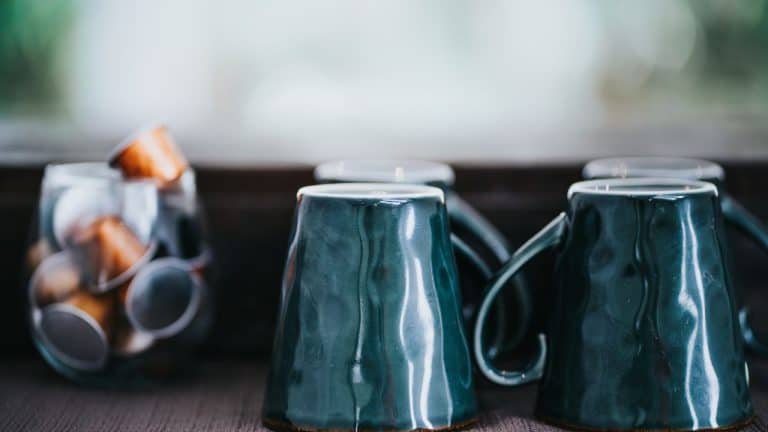Is a latte less acidic than coffee: Acidity Comparison
In this article we'll take a look at the question is a latte less acidic than coffee, but first we need to understand acidity at a basic level.
If you’re a coffee lover, chances are you’ve wondered if there’s any difference between a latte and regular coffee when it comes to acidity.
Well, the answer is that there is a difference, and understanding it can help you make an informed decision about your coffee choice. Let’s break down the difference in acidity between coffee and lattes.

What is Acidity in Coffee?
Instead, acidity refers to the flavor profile of coffee; specifically, how tart or sour a particular cup of joe tastes. Generally speaking, coffees with higher acidities have brighter flavors that are more vibrant and often fruity (think citrus).

Low-acidity coffees tend to have milder flavors that are smoother and less intense.
How Does a Latte Compare to Coffee?
Now let's get into the nitty-gritty - how does the acidity of a latte compare to regular brewed coffee?
The answer depends on several factors, including the type of beans used and how they're brewed. Generally speaking, brewed coffees tend to be slightly more acidic than lattes since they don't contain milk.
Lattes also generally contain more caffeine than regular brewed coffee because espresso shots are added for extra flavor.
But don't worry - unless you're very sensitive to caffeine, this won't affect your overall energy levels too much!
So, Is a latte Less Acidic than Coffee
A latte and a cup of coffee may look very similar, but there is a difference on the inside that can help prevent that "acidic" feeling in your stomach.
A latte is significantly less acidic than a cup of coffee because of the added milk and foam. Most types of milk contain calcium that can help balance the natural acids found in the coffee beans, reducing their acidity.
An espresso itself has little-to-no acidity compared to a standard cup of drip coffee, since it's made with much more concentrated doses of finely ground beans.

When combined with steamed milk and/or foam, an espresso takes up even more surface area than when served alone and further reduces its potential acidity.
So if you're worried about drinking something too acidic, opt for a latte instead!
Does Acidity Affect Your Health?
It's important to note that even though differences in acidity do exist between different types of coffee drinks, most won't have much effect on your health.
This is because all coffees contain relatively low levels of acids compared to other foods and drinks like wine or soda - so no need to worry about drinking too much!
However, if you find yourself getting heartburn or indigestion after drinking certain types of coffees (or other caffeinated beverages), it may be worth cutting back on them or avoiding them altogether until you can figure out which one is causing these issues.
Types of High Acidic Coffee Beans
Coffee lovers rejoice, for there are several types of high acidic coffee beans available to choose from! High acidic beans provide a more intense flavor and can often be described as having a fruity flavor profile.
Some popular choices include Ethiopian Yirgacheffe, Sumatra Mandheling, Kenyan AA, and Guatemala Antigua.

Each type of bean offers its own unique taste that is sure to please the palate. While some people prefer their coffee with less acidity than offered by these beans, high acidic coffees offer an experience like no other.
With so many varieties to choose from, you're sure to find an option that suits your specific tastes.
Types of Low Acidic Coffee Beans
Many people struggle to decide between regular coffee and low acidic coffee. There are different types of low acidic coffees, including cold brew, velvety dark roast, and high-elevation grown varieties.
Coffee beans naturally produce a certain level of acidity as they're roasted, so it's important to find the right type that produces the flavor you want while minimizing unpleasant side effects like stomach irritation or heartburn.
Cold Brew is made by steeping ground coffee in room temperature or cold water for about 12 hours which extracts flavor without creating an overbearing acidic taste.
Velvety dark roast tends to have a bolder taste than other coffees but with a lower acid level than its light roast counterparts.
High-elevation grown coffees tend to have a milder taste compared with darker beans and can be great options if you're looking to avoid a strong acidic flavor while not sacrificing too much on the depth of your drink's flavor.
PH Scale
The pH scale is extremely useful for determining the acidity of different solutions. It works by assigning values from 0 to 14, where 0 is the most acidic and 14 is the most basic.
For example, a pH level of 7 is determined to be neutral – neither acidic nor basic. Knowing the pH of a solution can be important in many fields ranging from cosmetics to agriculture.

Chemical analyses can even positively impact food safety or quality assurance testing! While a conversation about pH may not be the most exciting topic, understanding how it works certainly has its advantages!
PH Levels: Latte vs Coffee
Coffee is an item that a lot of people are familiar with and don't think twice about. Little do they know, the pH of their cup of joe has a lot to do with its flavor and quality!
When it comes to coffee, the ideal pH for brewed beans is slightly on the acidic side — around 4.85. As for those sweeter variations - lattes - the idea pH is a few points more on the neutral side at 6.4.
This slightly more alkaline range ensures that there's enough acidity in your latte for maximum enjoyment without overpowering you with sharpness like espresso tends to do.
Overall, knowing what pH level works best for your type of liquid is important when trying to brew or mix up a delicious cup of coffee or latte!
FAQs
Are lattes better for GERD
Around the world, lattes, cappuccinos and other creamy hot drinks are a must-have for any coffee enthusiast.
But, if you suffer from GERD, these tasty treats may need to be consumed with caution. Lattes contain a much lower acidity level than their other non-alcoholic cafe cousins (think regular brewed coffee), meaning they could be better tolerated by those with GERD.

While many of us enjoy the flavor of more acidic drinks and coffees when we sip them by themselves, adding dairy can help neutralize some of that acid in your cup.
So if it's both taste and GERD friendliness that you're after, then a latte might be just what the doctor ordered!
Is coffee with milk easier on the stomach
When it comes to coffee and your stomach, the jury is still out. Some people swear by black coffee because they believe that milk causes more gastric distress, while others find that milk in their coffee helps to reduce the acidity of the beverage.
The truth is, everyone’s body chemistry is going to affect how they experience coffee differently and there is no one-size-fits-all solution.
If you are a fan of lattes or cappuccinos, adding milk might make all the difference when it comes to settling your stomach; however if you’re drinking regular brewed coffee then making sure you enjoy it slowly may be a better option.
Whatever your preference, just listen to your body and choose what works for you!
Do lattes cause acid reflux
Do lattes cause acid reflux? Good question! Lattes are made with steamed milk or cream and espresso, along with other ingredients like flavored syrups.
They can be a great pick-me-up for the morning, but because of some of the ingredients, it's easy to see why some people might be concerned about whether they can aggravate acid reflux.

Generally speaking, those with existing acid reflux should have no more than eight ounces of whole milk at one time if they're going to indulge in a latte.
Those without preexisting issues could enjoy them more frequently without issue.
Also keep in mind that sweetened syrups may contain artificial flavors that could trigger further indigestion, so it's wise to opt for sauces that are all-natural when possible.
What type of coffee is least acidic
If you're looking for a coffee that won't irritate your stomach, consider choosing one of the lower-acid varieties.
Alkaline coffee has a smoother taste and is less harsh than traditional coffees since it contains fewer acidic compounds and is lower on the pH scale.
It's generally easier on sensitive digestive systems, so if you have problems with traditional coffees, try out an alkaline blend!
Additionally, dark roasts tend to be lower in acidity content than light or medium roasts due to the longer time they spend being roasted; however, this difference may be more subtle than that between traditional and alkaline coffees.
Final Thoughts is a Latte Less Acidic Than Coffee
All in all, while there are some differences between the acidity levels of different types of coffees (such as lattes versus regular brewed cups), these differences aren't likely to have much effect on your overall health.
So go ahead—enjoy that cup o' joe! Just remember that if you experience any discomfort after drinking caffeinated beverages like lattes or regular brewed cups of coffee, it might be best for you to cut back on them until you can figure out which one is causing those issues. Happy sipping!







